May 19, 2016 at 10:42 am
[caption id="attachment_1496" align="alignright" width="410"]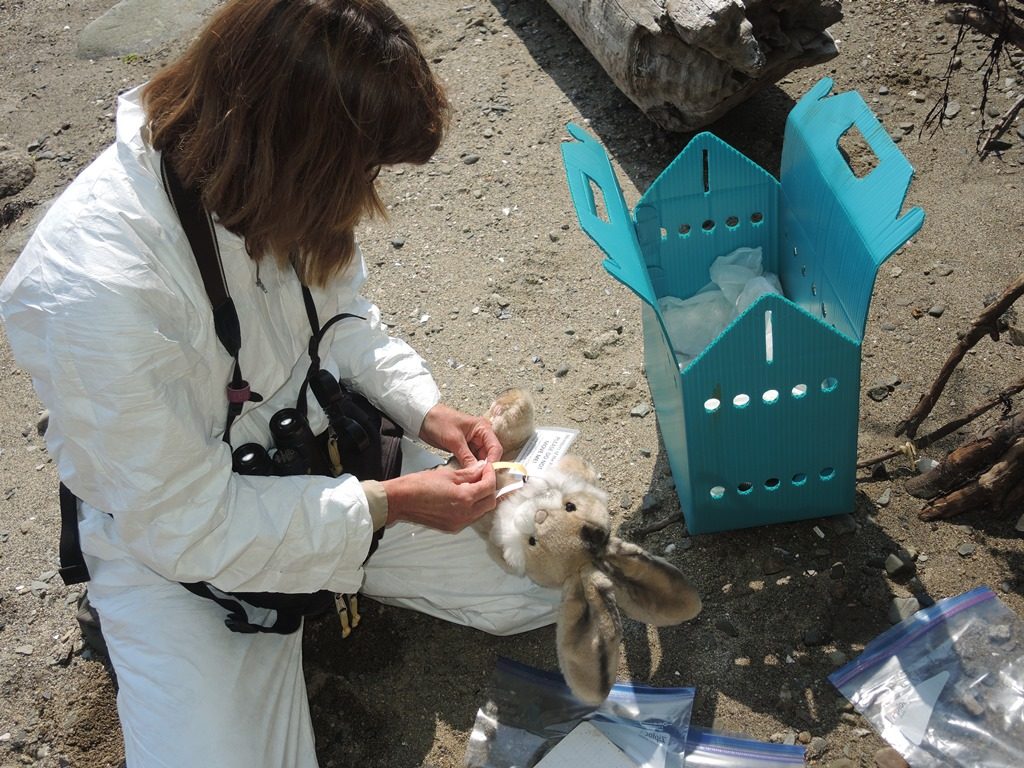 Biologists locate, capture and assess oiled wildlife in a mock oil spill scenario.[/caption]
The Department’s mission is to “protect, conserve and enhance” Maine’s fish and wildlife resources. For the most
part, this is done proactively, through monitoring of populations, adjusting harvest limits or season lengths, and restoring or preserving habitat. Occasionally though, the department must react to a crisis such as an oil spill to protect or conserve Maine’s wildlife.
The threat of a fuel spill in Maine is very real. Maine averages approximately 70 oil or fuel spills a year. That’s one every five days. They range in volume from a few gallons that may create a sheen on the water to the Julie N spill in 1996 that dumped nearly 180,000 gallons into the Fore River and Portland Harbor after a crash into a bridge ripped a 30 foot gash in the Julie N hull.
[caption id="attachment_1498" align="alignright" width="297"]
Biologists locate, capture and assess oiled wildlife in a mock oil spill scenario.[/caption]
The Department’s mission is to “protect, conserve and enhance” Maine’s fish and wildlife resources. For the most
part, this is done proactively, through monitoring of populations, adjusting harvest limits or season lengths, and restoring or preserving habitat. Occasionally though, the department must react to a crisis such as an oil spill to protect or conserve Maine’s wildlife.
The threat of a fuel spill in Maine is very real. Maine averages approximately 70 oil or fuel spills a year. That’s one every five days. They range in volume from a few gallons that may create a sheen on the water to the Julie N spill in 1996 that dumped nearly 180,000 gallons into the Fore River and Portland Harbor after a crash into a bridge ripped a 30 foot gash in the Julie N hull.
[caption id="attachment_1498" align="alignright" width="297"]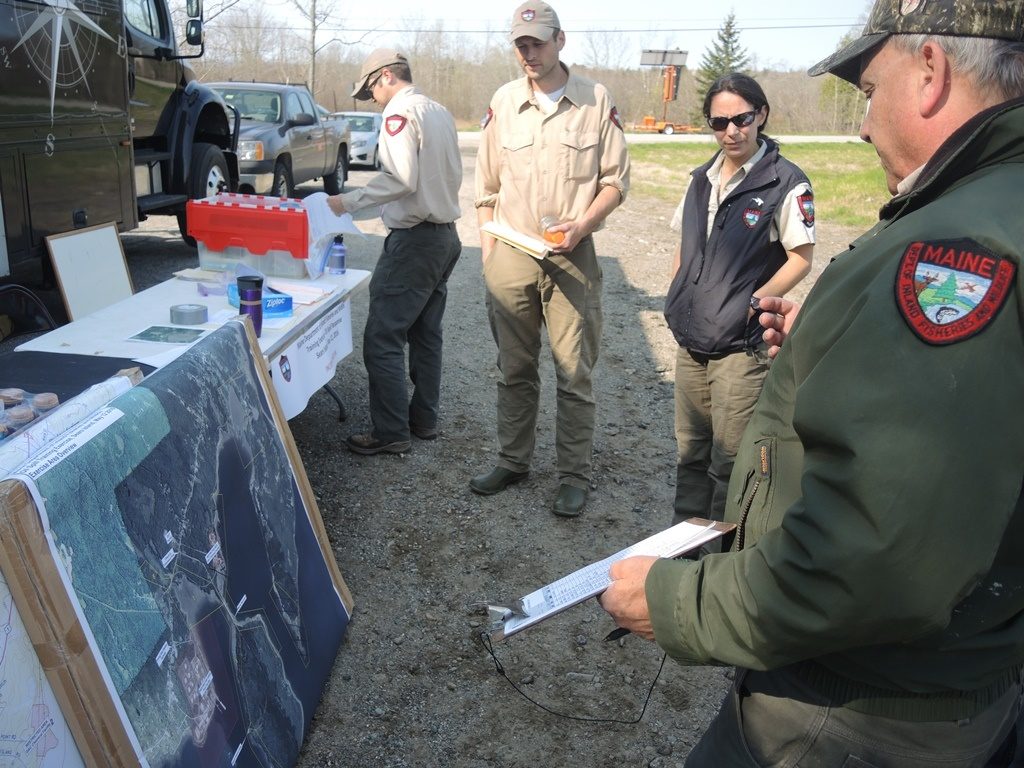 Before heading out into the spill area, biologists are briefed on the scenario and assigned a grid to search.[/caption]
With Casco Bay’s rich and diverse wildlife and fisheries and the fact that Portland is the second largest oil port on the East Coast, it makes sense to be prepared for any type of spill.
Last week department biologists, along with several game wardens and members of the Maine Department of Environmental Protection, met in Searsport to conduct a mock oil spill drill.
In a real spill, IFW’s focus would be on Maine’s fish and wildlife resources. The Department of Environmental Protection would be in charge of containing and then the cleaning of the spill. Depending on the location, other agencies, both state and federal could be involved as well.
[caption id="attachment_1495" align="alignright" width="413"]
Before heading out into the spill area, biologists are briefed on the scenario and assigned a grid to search.[/caption]
With Casco Bay’s rich and diverse wildlife and fisheries and the fact that Portland is the second largest oil port on the East Coast, it makes sense to be prepared for any type of spill.
Last week department biologists, along with several game wardens and members of the Maine Department of Environmental Protection, met in Searsport to conduct a mock oil spill drill.
In a real spill, IFW’s focus would be on Maine’s fish and wildlife resources. The Department of Environmental Protection would be in charge of containing and then the cleaning of the spill. Depending on the location, other agencies, both state and federal could be involved as well.
[caption id="attachment_1495" align="alignright" width="413"]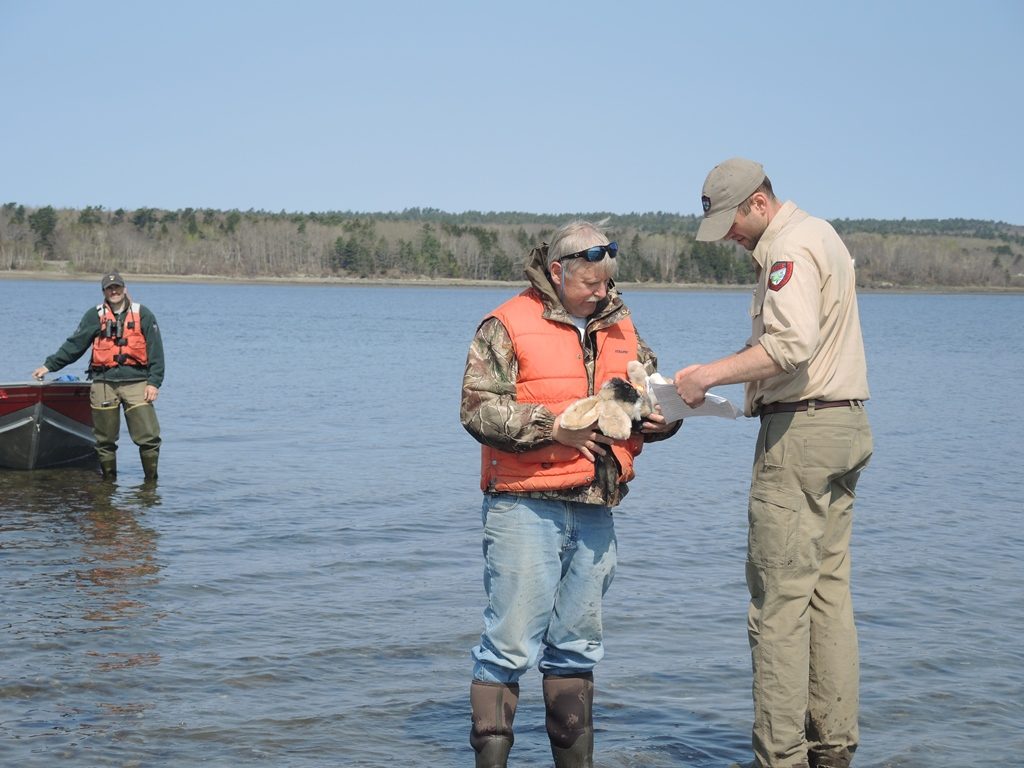 In an actual spill, oiled wildlife is transported in the quickest and most efficient way possible, so that they can be stabilized and sent to a rehabilitation center. Here an oiled bunny that was captured at the southern tip of the island is transferred to a biologist who will bring it to the triage center.[/caption]
Searsport’s mock oil spill was based upon the very real scenario of a small vessel becoming grounded, breaking up, and diesel fuel being spilled into the bay. IFW’s role was to search areas affected by the spill, locate and capture any oiled wildlife, document its location, then transfer it to a triage area where the wildlife would be stabilized before being transported to a wildlife rehabilitation center. Teams also work on preventing more wildlife from becoming oiled by scaring them away with noise.
Much like a missing person search conducted by the Maine Warden Service, areas are segmented into grids, and then teams of biologists are assigned to search the grids. Six different areas around Sears Island were affected by the mock spill and then searched, and a boat was also on scene to help transport wildlife quickly from remote areas to the triage area.
[caption id="attachment_1500" align="alignright" width="395"]
In an actual spill, oiled wildlife is transported in the quickest and most efficient way possible, so that they can be stabilized and sent to a rehabilitation center. Here an oiled bunny that was captured at the southern tip of the island is transferred to a biologist who will bring it to the triage center.[/caption]
Searsport’s mock oil spill was based upon the very real scenario of a small vessel becoming grounded, breaking up, and diesel fuel being spilled into the bay. IFW’s role was to search areas affected by the spill, locate and capture any oiled wildlife, document its location, then transfer it to a triage area where the wildlife would be stabilized before being transported to a wildlife rehabilitation center. Teams also work on preventing more wildlife from becoming oiled by scaring them away with noise.
Much like a missing person search conducted by the Maine Warden Service, areas are segmented into grids, and then teams of biologists are assigned to search the grids. Six different areas around Sears Island were affected by the mock spill and then searched, and a boat was also on scene to help transport wildlife quickly from remote areas to the triage area.
[caption id="attachment_1500" align="alignright" width="395"]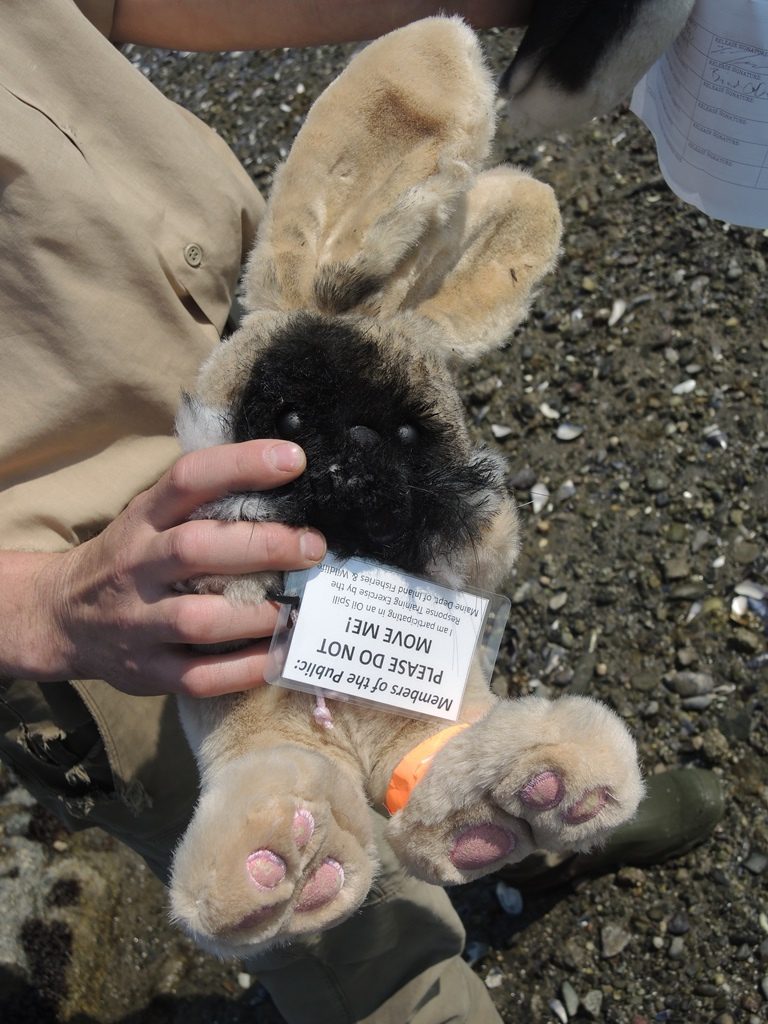 black paint is a good substitute for oil in a training scenario.[/caption]
Areas affected by the spill were marked with orange boundary flags, and stuffed animals affected by black paint were placed in different areas to simulate the spill and its effects.
The scenario unfolded well. Teams were dispatched to different map grids as they arrived, animals impacted by the spill were located relatively quickly and whisked to the triage center, and the exercise was completed with all animals being located and treated.
The drill trains and prepares staff for a true crisis scenario. The training transfers to other crisis-type scenarios such as an avian influenza outbreak, a chronic wasting disease response or other natural disaster. It allows staff to get experience in a realistic situation, allows for interagency cooperation, and to improve for future responses.
The mock scenario and planning is funded through the Maine Coastal & Inland Surface Oil Clean-up Fund which assesses a fee on the transfer or transport of crude or petroleum products from vessel to terminal, on the import of petroleum products into Maine by road or rail, and for the transfer of product from terminal to vessel.
In the case of a real spill, the spiller is responsible for paying for all costs associated with responding to an oil spill including staff time, equipment, and bird cleaning/rehabilitation.
If you are interested in looking at some news coverage of the spill, please check out WLBZ and WABI’s coverage of the exercise at:
Maine IFW and DEP team up to fight oil spills
http://www.wlbz2.com/news/local/maine-ifw-and-dep-team-up-to-fight-oil-spills/187729233
Maine Dept. of IFW Holds Mock Oil Spill Training Scenario in Searsport
http://wabi.tv/2016/05/12/maine-dept-of-ifw-holds-mock-oil-spill-training-scenario-in-searsport/
[caption id="attachment_1497" align="aligncenter" width="1024"]
black paint is a good substitute for oil in a training scenario.[/caption]
Areas affected by the spill were marked with orange boundary flags, and stuffed animals affected by black paint were placed in different areas to simulate the spill and its effects.
The scenario unfolded well. Teams were dispatched to different map grids as they arrived, animals impacted by the spill were located relatively quickly and whisked to the triage center, and the exercise was completed with all animals being located and treated.
The drill trains and prepares staff for a true crisis scenario. The training transfers to other crisis-type scenarios such as an avian influenza outbreak, a chronic wasting disease response or other natural disaster. It allows staff to get experience in a realistic situation, allows for interagency cooperation, and to improve for future responses.
The mock scenario and planning is funded through the Maine Coastal & Inland Surface Oil Clean-up Fund which assesses a fee on the transfer or transport of crude or petroleum products from vessel to terminal, on the import of petroleum products into Maine by road or rail, and for the transfer of product from terminal to vessel.
In the case of a real spill, the spiller is responsible for paying for all costs associated with responding to an oil spill including staff time, equipment, and bird cleaning/rehabilitation.
If you are interested in looking at some news coverage of the spill, please check out WLBZ and WABI’s coverage of the exercise at:
Maine IFW and DEP team up to fight oil spills
http://www.wlbz2.com/news/local/maine-ifw-and-dep-team-up-to-fight-oil-spills/187729233
Maine Dept. of IFW Holds Mock Oil Spill Training Scenario in Searsport
http://wabi.tv/2016/05/12/maine-dept-of-ifw-holds-mock-oil-spill-training-scenario-in-searsport/
[caption id="attachment_1497" align="aligncenter" width="1024"]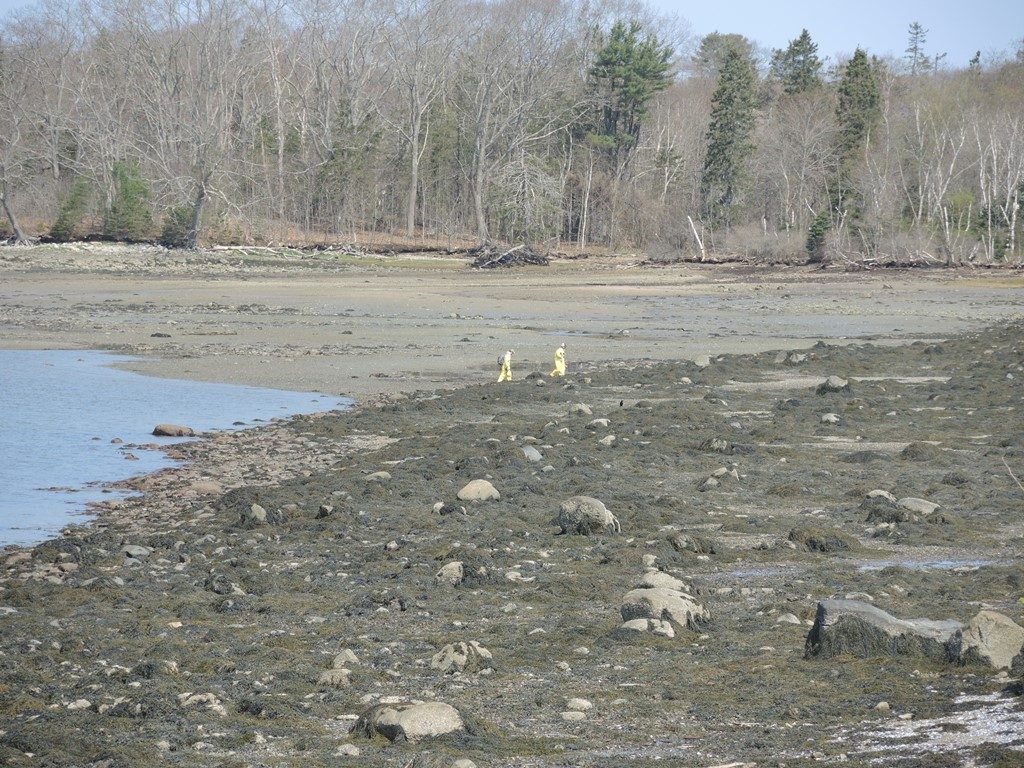 Biologists search an oiled area in protective gear for oiled wildlife.[/caption]
Biologists search an oiled area in protective gear for oiled wildlife.[/caption]
 Biologists locate, capture and assess oiled wildlife in a mock oil spill scenario.[/caption]
The Department’s mission is to “protect, conserve and enhance” Maine’s fish and wildlife resources. For the most
part, this is done proactively, through monitoring of populations, adjusting harvest limits or season lengths, and restoring or preserving habitat. Occasionally though, the department must react to a crisis such as an oil spill to protect or conserve Maine’s wildlife.
The threat of a fuel spill in Maine is very real. Maine averages approximately 70 oil or fuel spills a year. That’s one every five days. They range in volume from a few gallons that may create a sheen on the water to the Julie N spill in 1996 that dumped nearly 180,000 gallons into the Fore River and Portland Harbor after a crash into a bridge ripped a 30 foot gash in the Julie N hull.
[caption id="attachment_1498" align="alignright" width="297"]
Biologists locate, capture and assess oiled wildlife in a mock oil spill scenario.[/caption]
The Department’s mission is to “protect, conserve and enhance” Maine’s fish and wildlife resources. For the most
part, this is done proactively, through monitoring of populations, adjusting harvest limits or season lengths, and restoring or preserving habitat. Occasionally though, the department must react to a crisis such as an oil spill to protect or conserve Maine’s wildlife.
The threat of a fuel spill in Maine is very real. Maine averages approximately 70 oil or fuel spills a year. That’s one every five days. They range in volume from a few gallons that may create a sheen on the water to the Julie N spill in 1996 that dumped nearly 180,000 gallons into the Fore River and Portland Harbor after a crash into a bridge ripped a 30 foot gash in the Julie N hull.
[caption id="attachment_1498" align="alignright" width="297"] Before heading out into the spill area, biologists are briefed on the scenario and assigned a grid to search.[/caption]
With Casco Bay’s rich and diverse wildlife and fisheries and the fact that Portland is the second largest oil port on the East Coast, it makes sense to be prepared for any type of spill.
Last week department biologists, along with several game wardens and members of the Maine Department of Environmental Protection, met in Searsport to conduct a mock oil spill drill.
In a real spill, IFW’s focus would be on Maine’s fish and wildlife resources. The Department of Environmental Protection would be in charge of containing and then the cleaning of the spill. Depending on the location, other agencies, both state and federal could be involved as well.
[caption id="attachment_1495" align="alignright" width="413"]
Before heading out into the spill area, biologists are briefed on the scenario and assigned a grid to search.[/caption]
With Casco Bay’s rich and diverse wildlife and fisheries and the fact that Portland is the second largest oil port on the East Coast, it makes sense to be prepared for any type of spill.
Last week department biologists, along with several game wardens and members of the Maine Department of Environmental Protection, met in Searsport to conduct a mock oil spill drill.
In a real spill, IFW’s focus would be on Maine’s fish and wildlife resources. The Department of Environmental Protection would be in charge of containing and then the cleaning of the spill. Depending on the location, other agencies, both state and federal could be involved as well.
[caption id="attachment_1495" align="alignright" width="413"] In an actual spill, oiled wildlife is transported in the quickest and most efficient way possible, so that they can be stabilized and sent to a rehabilitation center. Here an oiled bunny that was captured at the southern tip of the island is transferred to a biologist who will bring it to the triage center.[/caption]
Searsport’s mock oil spill was based upon the very real scenario of a small vessel becoming grounded, breaking up, and diesel fuel being spilled into the bay. IFW’s role was to search areas affected by the spill, locate and capture any oiled wildlife, document its location, then transfer it to a triage area where the wildlife would be stabilized before being transported to a wildlife rehabilitation center. Teams also work on preventing more wildlife from becoming oiled by scaring them away with noise.
Much like a missing person search conducted by the Maine Warden Service, areas are segmented into grids, and then teams of biologists are assigned to search the grids. Six different areas around Sears Island were affected by the mock spill and then searched, and a boat was also on scene to help transport wildlife quickly from remote areas to the triage area.
[caption id="attachment_1500" align="alignright" width="395"]
In an actual spill, oiled wildlife is transported in the quickest and most efficient way possible, so that they can be stabilized and sent to a rehabilitation center. Here an oiled bunny that was captured at the southern tip of the island is transferred to a biologist who will bring it to the triage center.[/caption]
Searsport’s mock oil spill was based upon the very real scenario of a small vessel becoming grounded, breaking up, and diesel fuel being spilled into the bay. IFW’s role was to search areas affected by the spill, locate and capture any oiled wildlife, document its location, then transfer it to a triage area where the wildlife would be stabilized before being transported to a wildlife rehabilitation center. Teams also work on preventing more wildlife from becoming oiled by scaring them away with noise.
Much like a missing person search conducted by the Maine Warden Service, areas are segmented into grids, and then teams of biologists are assigned to search the grids. Six different areas around Sears Island were affected by the mock spill and then searched, and a boat was also on scene to help transport wildlife quickly from remote areas to the triage area.
[caption id="attachment_1500" align="alignright" width="395"] black paint is a good substitute for oil in a training scenario.[/caption]
Areas affected by the spill were marked with orange boundary flags, and stuffed animals affected by black paint were placed in different areas to simulate the spill and its effects.
The scenario unfolded well. Teams were dispatched to different map grids as they arrived, animals impacted by the spill were located relatively quickly and whisked to the triage center, and the exercise was completed with all animals being located and treated.
The drill trains and prepares staff for a true crisis scenario. The training transfers to other crisis-type scenarios such as an avian influenza outbreak, a chronic wasting disease response or other natural disaster. It allows staff to get experience in a realistic situation, allows for interagency cooperation, and to improve for future responses.
The mock scenario and planning is funded through the Maine Coastal & Inland Surface Oil Clean-up Fund which assesses a fee on the transfer or transport of crude or petroleum products from vessel to terminal, on the import of petroleum products into Maine by road or rail, and for the transfer of product from terminal to vessel.
In the case of a real spill, the spiller is responsible for paying for all costs associated with responding to an oil spill including staff time, equipment, and bird cleaning/rehabilitation.
If you are interested in looking at some news coverage of the spill, please check out WLBZ and WABI’s coverage of the exercise at:
Maine IFW and DEP team up to fight oil spills
http://www.wlbz2.com/news/local/maine-ifw-and-dep-team-up-to-fight-oil-spills/187729233
Maine Dept. of IFW Holds Mock Oil Spill Training Scenario in Searsport
http://wabi.tv/2016/05/12/maine-dept-of-ifw-holds-mock-oil-spill-training-scenario-in-searsport/
[caption id="attachment_1497" align="aligncenter" width="1024"]
black paint is a good substitute for oil in a training scenario.[/caption]
Areas affected by the spill were marked with orange boundary flags, and stuffed animals affected by black paint were placed in different areas to simulate the spill and its effects.
The scenario unfolded well. Teams were dispatched to different map grids as they arrived, animals impacted by the spill were located relatively quickly and whisked to the triage center, and the exercise was completed with all animals being located and treated.
The drill trains and prepares staff for a true crisis scenario. The training transfers to other crisis-type scenarios such as an avian influenza outbreak, a chronic wasting disease response or other natural disaster. It allows staff to get experience in a realistic situation, allows for interagency cooperation, and to improve for future responses.
The mock scenario and planning is funded through the Maine Coastal & Inland Surface Oil Clean-up Fund which assesses a fee on the transfer or transport of crude or petroleum products from vessel to terminal, on the import of petroleum products into Maine by road or rail, and for the transfer of product from terminal to vessel.
In the case of a real spill, the spiller is responsible for paying for all costs associated with responding to an oil spill including staff time, equipment, and bird cleaning/rehabilitation.
If you are interested in looking at some news coverage of the spill, please check out WLBZ and WABI’s coverage of the exercise at:
Maine IFW and DEP team up to fight oil spills
http://www.wlbz2.com/news/local/maine-ifw-and-dep-team-up-to-fight-oil-spills/187729233
Maine Dept. of IFW Holds Mock Oil Spill Training Scenario in Searsport
http://wabi.tv/2016/05/12/maine-dept-of-ifw-holds-mock-oil-spill-training-scenario-in-searsport/
[caption id="attachment_1497" align="aligncenter" width="1024"] Biologists search an oiled area in protective gear for oiled wildlife.[/caption]
Biologists search an oiled area in protective gear for oiled wildlife.[/caption]